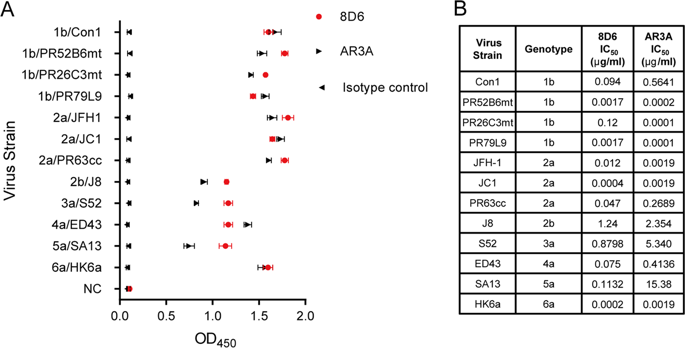当前位置:
X-MOL 学术
›
Cell. Mol. Immunol.
›
论文详情
Our official English website, www.x-mol.net, welcomes your
feedback! (Note: you will need to create a separate account there.)
Junctional and somatic hypermutation-induced CX4C motif is critical for the recognition of a highly conserved epitope on HCV E2 by a human broadly neutralizing antibody.
Cellular & Molecular Immunology ( IF 21.8 ) Pub Date : 2020-03-31 , DOI: 10.1038/s41423-020-0403-1 Chunyan Yi 1 , Jing Xia 2 , Lan He 3, 4, 5 , Zhiyang Ling 1 , Xuesong Wang 2 , Yu Yan 2 , Jiangjun Wang 1 , Xinhao Zhao 2 , Weiguo Fan 2 , Xiaoyu Sun 1 , Ronghua Zhang 1 , Sheng Ye 6, 7 , Rongguang Zhang 6 , Yongfen Xu 2 , Liyan Ma 1 , Yaguang Zhang 1 , Honglin Zhou 8 , Zhong Huang 2 , Junqi Niu 9 , Gang Long 2 , Junxia Lu 3 , Jin Zhong 2 , Bing Sun 1
Cellular & Molecular Immunology ( IF 21.8 ) Pub Date : 2020-03-31 , DOI: 10.1038/s41423-020-0403-1 Chunyan Yi 1 , Jing Xia 2 , Lan He 3, 4, 5 , Zhiyang Ling 1 , Xuesong Wang 2 , Yu Yan 2 , Jiangjun Wang 1 , Xinhao Zhao 2 , Weiguo Fan 2 , Xiaoyu Sun 1 , Ronghua Zhang 1 , Sheng Ye 6, 7 , Rongguang Zhang 6 , Yongfen Xu 2 , Liyan Ma 1 , Yaguang Zhang 1 , Honglin Zhou 8 , Zhong Huang 2 , Junqi Niu 9 , Gang Long 2 , Junxia Lu 3 , Jin Zhong 2 , Bing Sun 1
Affiliation

|
Induction of broadly neutralizing monoclonal antibodies (bNAbs) that bind to the viral envelope glycoproteins is a major goal of hepatitis C virus (HCV) vaccine research. The study of bNAbs arising in natural infection is essential in this endeavor. We generated a human antibody, 8D6, recognizing the E2 protein of HCV isolated from a chronic hepatitis C patient. This antibody shows broadly neutralizing activity, which covers a pan-genotypic panel of cell culture-derived HCV virions (HCVcc). Functional and epitope analyses demonstrated that 8D6 can block the interaction between E2 and CD81 by targeting a highly conserved epitope on E2. We describe how the 8D6 lineage evolved via somatic hypermutation to achieve broad neutralization. We found that the V(D)J recombination-generated junctional and somatic hypermutation-induced disulfide bridge (C-C) motif in the CDRH3 is critical for the broad neutralization and binding activity of 8D6. This motif is conserved among a series of broadly neutralizing HCV antibodies, indicating a common binding model. Next, the 8D6 inferred germline (iGL) was reconstructed and tested for its binding affinity and neutralization activity. Interestingly, 8D6 iGL-mediated relatively strong inhibition of the 1b genotype PR79L9 strain, suggesting that PR79L9 may serve as a potential natural viral strain that provides E2 sequences that induce bNAbs. Overall, our detailed epitope mapping and genetic studies of the HCV E2-specific mAb 8D6 have allowed for further refinement of antigenic sites on E2 and reveal a new mechanism to generate a functional CDRH3, while its iGL can serve as a probe to identify potential HCV vaccine strains.
中文翻译:

连接和体细胞超突变诱导的 CX4C 基序对于人类广泛中和抗体识别 HCV E2 上高度保守的表位至关重要。
与病毒包膜糖蛋白结合的广泛中和单克隆抗体 (bNAb) 的诱导是丙型肝炎病毒 (HCV) 疫苗研究的主要目标。对自然感染中产生的 bNAb 的研究在这一努力中至关重要。我们生成了一种人类抗体 8D6,可识别从一名慢性丙型肝炎患者身上分离的 HCV 的 E2 蛋白。该抗体显示出广泛的中和活性,涵盖了细胞培养衍生的 HCV 病毒粒子 (HCVcc) 的泛基因型面板。功能和表位分析表明,8D6 可以通过靶向 E2 上高度保守的表位来阻断 E2 和 CD81 之间的相互作用。我们描述了 8D6 谱系如何通过体细胞超突变进化以实现广泛的中和。我们发现 CDRH3 中 V(D)J 重组产生的连接和体细胞超突变诱导的二硫键 (CC) 基序对于 8D6 的广泛中和和结合活性至关重要。该基序在一系列广泛中和的 HCV 抗体中是保守的,表明具有共同的结合模型。接下来,8D6 推断种系 (iGL) 被重建并测试其结合亲和力和中和活性。有趣的是,8D6 iGL 介导了对 1b 基因型 PR79L9 菌株的相对较强的抑制,这表明 PR79L9 可能作为一种潜在的天然病毒菌株,提供可诱导 bNAb 的 E2 序列。总体而言,我们对 HCV E2 特异性 mAb 8D6 的详细表位作图和遗传研究允许进一步改进 E2 上的抗原位点,并揭示产生功能性 CDRH3 的新机制,
更新日期:2020-04-24
中文翻译:

连接和体细胞超突变诱导的 CX4C 基序对于人类广泛中和抗体识别 HCV E2 上高度保守的表位至关重要。
与病毒包膜糖蛋白结合的广泛中和单克隆抗体 (bNAb) 的诱导是丙型肝炎病毒 (HCV) 疫苗研究的主要目标。对自然感染中产生的 bNAb 的研究在这一努力中至关重要。我们生成了一种人类抗体 8D6,可识别从一名慢性丙型肝炎患者身上分离的 HCV 的 E2 蛋白。该抗体显示出广泛的中和活性,涵盖了细胞培养衍生的 HCV 病毒粒子 (HCVcc) 的泛基因型面板。功能和表位分析表明,8D6 可以通过靶向 E2 上高度保守的表位来阻断 E2 和 CD81 之间的相互作用。我们描述了 8D6 谱系如何通过体细胞超突变进化以实现广泛的中和。我们发现 CDRH3 中 V(D)J 重组产生的连接和体细胞超突变诱导的二硫键 (CC) 基序对于 8D6 的广泛中和和结合活性至关重要。该基序在一系列广泛中和的 HCV 抗体中是保守的,表明具有共同的结合模型。接下来,8D6 推断种系 (iGL) 被重建并测试其结合亲和力和中和活性。有趣的是,8D6 iGL 介导了对 1b 基因型 PR79L9 菌株的相对较强的抑制,这表明 PR79L9 可能作为一种潜在的天然病毒菌株,提供可诱导 bNAb 的 E2 序列。总体而言,我们对 HCV E2 特异性 mAb 8D6 的详细表位作图和遗传研究允许进一步改进 E2 上的抗原位点,并揭示产生功能性 CDRH3 的新机制,











































 京公网安备 11010802027423号
京公网安备 11010802027423号